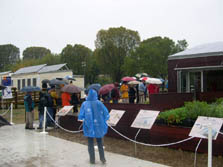

Despite the heavy rain, hundreds of visitors toured the Solar Decathlon solar village today. Here, visitors wait in the rain to enter the Cornell house.
Solar Decathlon 2005
Daily Journal — October 8, 2005
As I looked down Decathlete Way this morning it was filled with umbrellas as people worked their way from house to house in the pouring rain. The solar houses now became a refuge — a place to find shelter from the rain. The teams were very accommodating and welcomed everyone into their homes for a tour even though they were dripping wet. The basic design criteria for firmness and livability is easily understood on a day like today. The first thing we all seek in a home is shelter from the elements.
The second is energy. Today the Solar Decathlon started in earnest, and as of 8 a.m. the houses must prove they can power all their energy needs with solar energy. For the next seven days of the competition no matter what activity goes on, that activity must be accomplished from the solar systems integrated into the roof and walls of the house. These houses are designed to be totally energy self-sufficient. Sometimes described as energy independent homes, or zero energy homes, the object is to design a house that provides its own power. The Solar Decathlon will reward those who perform well, and starting today we will find out who best meets that challenge.
There is a clever saying from the movie Field of Dreams that rings true here: "build it and they will come." The interest in the competition is incredibly high. Hundreds of people braved the heavy rain and flooded lawns with three-inch deep puddles to tour the houses and learn about solar energy. Nobody had dry feet, and most were wet up to their knees. But lines formed early and remained long throughout the day as the village filled with hundreds of people. Even our consumer workshops for solar energy and energy efficiency were well attended. At 4 p.m. this afternoon there was still a steady stream of people walking through the village. The great turnout in the rain was heartwarming to all of us who worked so hard the past week to build the houses.
Three groups of jurors and judges began touring the houses today, and they'll finish their rounds tomorrow.
Architecture Jury
Criteria include firmness (strength, balance, and the integration of structure and enclosure), commodity (ease of entry, architectural strategy, and generosity of space), and delight (surprises, architectural attention inside and out, and lasting impression). These esteemed judges were hard at work today.
- Steve Badanes, Jersey Devil design/build
- Ed Mazria, Mazria Odems Dzurec
- Sarah Susanka, Susanka Studios
- Ken Wilson, Envision Design
Dwelling Panel of Judges
The dwelling judges evaluated the following criteria: livability (curb appeal, ease of traffic flow, and ease of maintenance) and buildability (appeal to builders, reproducibility, and marketability). The dwelling judges consisted of:
- Dennis Askins, Karim Rashid Design
- Bob Burt, Bozzuto Construction
- Sam Grawe, Dwell Magazine
- Katherine Salant, nationally syndicated columnist
House Tours Panel of Judges
Also today the teams were judged on their ability to communicate about their house. Criteria includes content (comprehensiveness, originality, and interest) and presentation (appropriateness, effectiveness, and effectiveness). Thanks to:
- Ben Finzel, Fleishman-Hillard, Inc.
- Jaime Van Mourik, National Building Museum
- Craig Savage, Building Media, Inc.
It was interesting to see the Architecture and Dwelling judges interact with the students, listening to their ideas about what drove the design of the house and then following up with questions about why various choices were made—and how they work in the real world. When the House Tour judges arrived they put themselves in the shoes of visitors to the Solar Decathlon, "experiencing" the student-led tours firsthand.
We have a huge appreciation for the contribution of these judges, who have brought their professional skills and expertise, as well as good spirits to the competition this weekend. We will all wait in anticipation to hear the results of their judging.
Reporting from the village,
Richard King, Department of Energy
